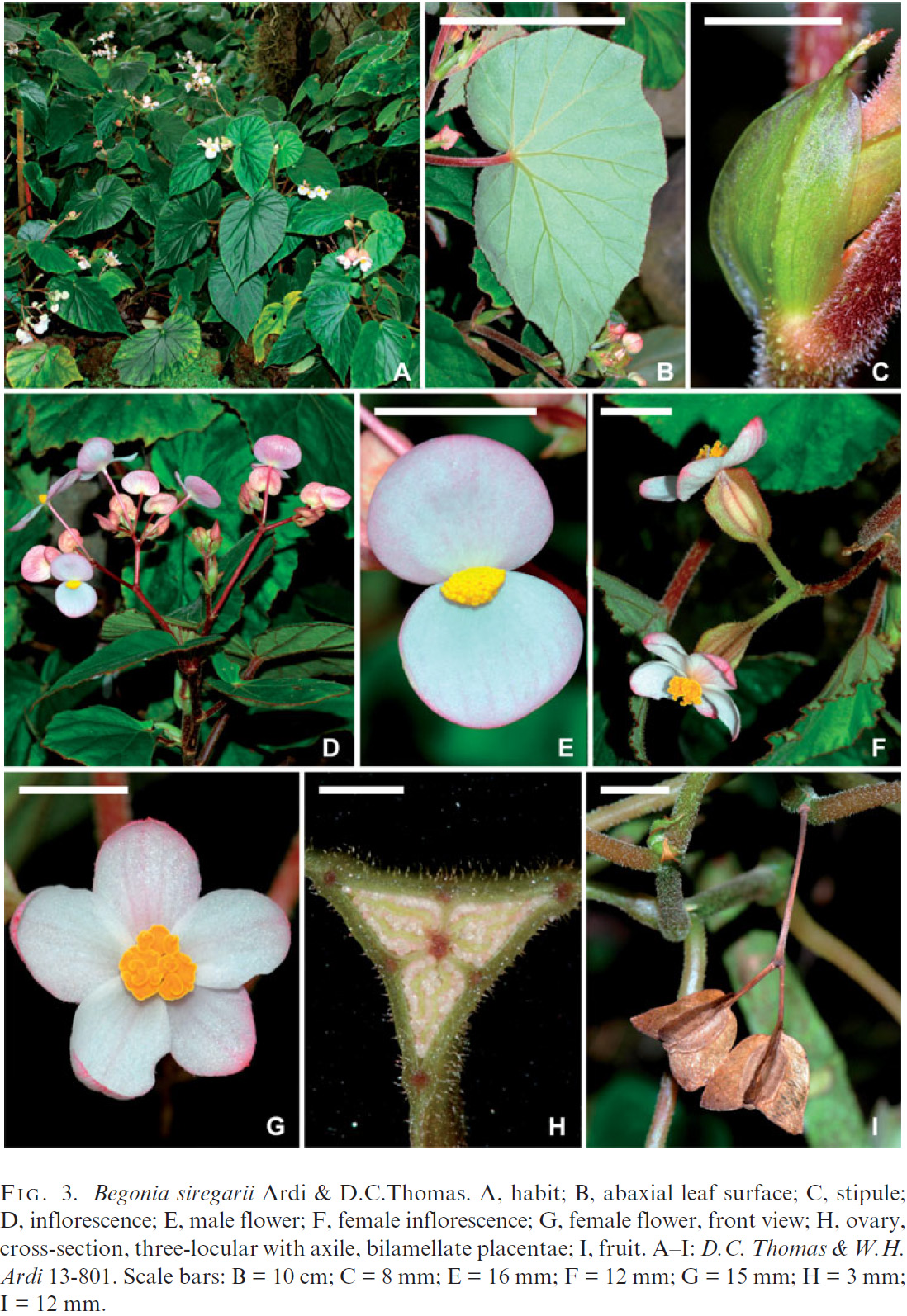Begonia siregarii in Edinburgh J. Bot. 71(2): 263. 2014
Primary tabs

Diagnosis
- Similar to Begonia prionota D.C.Thomas & Ardi. Differs from this species by its dentate-denticulate leaf margins (biserrate to shallowly lobed in B. prionota), the longer peduncles of the female inflorescences (2.2–4 cm vs. 1.2–2 cm), more strongly condensed monochasia, and entire tepals of the female flowers (irregularly serrate in B. prionota). (Ardi, W.H., Ardaka, I M., Hartutiningsih, I Nyoman Lugrayasa & Thomas, D.C. - Two new species of Begonia (Begoniaceae) from Sulawesi, Indonesia)
Description
- Perennial, monoecious herb with erect stems, to c.1 m tall, with a moderately dense to dense indumentum of white, multicellular, simple trichomes up to c.0.5 mm long and a sparse indumentum of microscopic, glandular trichomes on stems and leaves. Stems branched; internodes c.6.5–10.5 cm long, reddish to green. Leaves alternate; stipules caducous, 10–21 × 6–10 mm, slightly asymmetric, ovoid to elliptic, with an abaxially slightly prominent midrib projecting up to 5 mm at the apex; petioles 4–14 cm long, reddish; lamina basifixed, 7.5–23.5 × 4–14 cm, strongly asymmetric, ovate to elliptic, base cordate and lobes sometimes slightly overlapping, apex acute, margin irregularly and distantly dentate and denticulate between the larger teeth, the teeth long bristlepointed, adaxial surface dark green and abaxial surface pale green, primary veins 8–10, actinodromous, secondary veins craspedodromous. Inflorescences: protogynous; female inflorescences 2-flowered, one node basal to male inflorescences; peduncles 2.2–4 cm long; male inflorescence branched and composed of 3–5 cymose partial inflorescences, each showing (0–)1–3 basal dichasial branchings and several distal monochasial branchings, the internodes well developed in the basal part, but strongly to moderately condensed in the distal part; peduncles of partial inflorescences c.9–31 mm long. Male flowers : pedicels 23–28 mm long; tepals 2, white or white tinged with pink, cream coloured or cream coloured tinged with pink when young, 15–19 × 15–22 mm, broadly ovate to suborbicular, base slightly cordate, margin entire, apex rounded, abaxially with a sparse indumentum or glabrescent; androecium of c.50–90 stamens, yellow, filaments up to c.2 mm long, slightly fused at the very base, anthers up to c.1 mm long, obovate, dehiscing through unilaterally positioned slits > 1/2 as long as the anthers. Female flowers : pedicels 10–20 mm long; tepals 5, white tinged with pink, unequal, the smallest 14–27 × 6–8 mm, ovate to elliptic, the larger ones 18–29 × 10–20 mm, elliptic to oblong, the margin entire, sparsely to moderately hairy or almost glabrous; ovary ellipsoid, hairy, locules 3, placentation axile, placentae bilamellate, wings 3, equal, base rounded, apex truncate, margin entire, styles basally fused, 3 branched, each stylodium bifurcate in the stigmatic region, stigmatic surface a spirally twisted papillose band, yellow. Fruits : pedicels 10–20 mm long; ellipsoid, 10–16 × 5–7 mm (excluding the wings), sparsely to moderately hairy to glabrescent, wing shape as on ovary, 5–10 mm wide at the widest point (at the apex); seeds ellipsoidal, c.0.4–0.5 mm long, collar cells c.1/5–1/4 of the length of the seed. (Ardi, W.H., Ardaka, I M., Hartutiningsih, I Nyoman Lugrayasa & Thomas, D.C. - Two new species of Begonia (Begoniaceae) from Sulawesi, Indonesia)
Habitat
- Strongly disturbed secondary forest, forest floor, limestone, collected at c.800 m above sea level.
Etymology
- The species is named in honour of the former director of Bogor Botanic Gardens, Mr Mustaid Siregar, who collected living material of this species in 2007.
Notes
- The male inflorescence architecture (Fig. 3D) in combination with the long peduncles of the female inflorescences (2.2–4 cm long) (Fig. 3F) and the moderately dense to dense indumentum of relatively short (up to c.0.5 mm), white hairs on stems and leaves (Fig. 3C, I) differentiate this species from other Sulawesi Begonia species. Among Sulawesi Begonia only B. prionota D.C.Thomas & Ardi shows a similar character
combination. The male partial inflorescences are more condensed in Begonia siregarii , however, and the length of the peduncles of the female inflorescences, the dentate-denticulate leaf margins and entire tepals of the female flowers further differentiate B. siregarii from B. prionota , which shows shorter peduncles (c.1.2–2 cm), biserrate to shallowly lobed leaf margins and characteristic irregularly serrate tepal
margins.
In molecular phylogenetic analyses on the basis of non-coding plastid DNA data, Begonia siregarii (accession DCT 09-51) is nested in a clade with other species from Central and South Sulawesi, including B. ozotothrix D.C.Thomas, B. nobmanniae D.C.Thomas & Ardi, B. didyma, B. prionota and material of some undescribed species (Thomas, 2010 ; Thomas et al. , 2011 ). Begonia didyma and B. nobmanniae are smaller-leaved and relatively delicate plants vegetatively highly dissimilar to the much more robust B. siregarii. Begonia ozotothrix can readily be distinguished by the very short peduncles (1–5 mm) and pedicels (1–4 mm) of the female inflorescences and flowers, respectively, as well as the strongly condensed male partial inflorescences. (Ardi, W.H., Ardaka, I M., Hartutiningsih, I Nyoman Lugrayasa & Thomas, D.C. - Two new species of Begonia (Begoniaceae) from Sulawesi, Indonesia)

